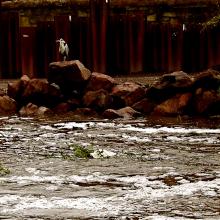
Local reactions to flood defence works between Bonnington and Canonmills have ranged from horror to fascination over recent months. Spurtle spoke to Laggan Construction’s Stakeholder Manager Stewart Mackay to establish some facts.
The first thing to know is that the raised, red roadways are only temporary. The original earth bank was removed and put into storage in Leith. A plastic blanket was then laid on which clean stone was compressed to form a robust platform for pile-driving machinery.
These platforms will eventually be removed and the original banks restored. Contrary to widespread misgivings, the platforms are carefully designed as part of a hydraulic model so as not to add to the risk of flood during periods of heavy rainfall.[img_assist|nid=1957|title=|desc=|link=node|align=right|width=200|height=172]
The height of new flood defence walls will vary from 1.7–2.1m in Bonnington, to around 1.3m by St Mark’s Bridge (where there will also be a raised walkway), and 1.8m on the upstream section up to Canonmills. Beside Powderhall, the wall will only rise about 30cms above ground level, but will form a deep L underground to prevent water scouring away the bank. Downstream from the weir below Redbraes, the piles will be particularly deep. The aim is to prevent any recurrence of water seaping under the flood wall and bubbling up in gardens on the other side in a syphon effect.
When the original soil is eventually returned, it will be without invasive plant species such as Giant Hogweed and Japanese Knot Weed. A replanting programme developed with the Council and Water of Leith Conservation Trust will then reintroduce plants and trees, creating a riverine environment appropriate for this part of Scotland.[img_assist|nid=1958|title=|desc=|link=node|align=right|width=197|height=200]
Despite heavy rainfall lately, the river has not breached its bounds. Problems have arisen, though, where rising river levels have shut the flat valves where drains normally debouch. This has caused a few surface-water difficulties, particularly in Stockbridge, but is – as far as Spurtle can work out – practically unavoidable.
Finally, the pipe discharging from beneath contractors’ portaloos on Warriston Rd feeds directly into a sewer, NOT into the Water of Leith.
At present, around 60 people are working on the flood defences, which are designed to protect around 480 homes between Bonnington and Stockbridge. This first phase of the £80m project is on schedule to finish at the end of the summer in 2012. Laggan will run a series of guided walks for locals to explain the works this August, details of which will appear here.
If you have questions of your own, Stewart Mackay is happy to answer them on: Freefone 0333 2020121. AM
[img_assist|nid=1959|title=|desc=|link=node|align=middle|width=640|height=480]